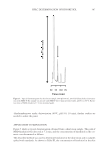VIRGIN OLIVE OIL–BASED COSMETIC CREAMS 377 increasing oil concentration resulted in increasing fruitiness, the selected range of oil concentration leading to creams with odors of signifi cantly different fruitiness. The odor of creams containing 10% of oil was rated as signifi cantly fruitier than that of those creams containing 3% and 5% of oil whereas no difference was found between creams containing oil at the latter two concentrations. The fruitiness perceived in the odor of creams prepared from oil A (more intensely greenly, fruity, and grass/leaf-greenly than for the other oils) was signifi cantly (p 0.0001) more intense than in that perceived in the odor of the other creams. Accord- ing to these results, an intense fruity odor of the starting olive oil (above four on the Table III Average Intensity of Sensory Attributes According to Cream Cream Fruity odor Defective odor AC3 1.1b,c 0.0d AC5 2.0a–c 0.0d AC10 3.6a 0.0d BC3 0.7b,c 0.0d BC5 0.6b,c 0.0d BC10 1.7a–c 0.0d CC3 0.5b,c 0.0d CC5 0.8b,c 0.0d CC10 2.2a,b 0.0d DC3 0.3b,c 1.8c DC5 0.9b,c 4.4b DC10 0.2c 6.7a EC3 0.0c 0.0d EC5 0.0c 0.0d EC10 0.0c 0.0d AH3 0.8b,c 0.0d AH5 1.5b,c 0.0d AH10 1.3b,c 0.0d BH3 0.9b,c 0.0d BH5 0.7b,c 0.0d BH10 1.4b,c 0.0d CH3 0.3b,c 0.0d CH5 0.5b,c 0.0d CH10 1.7a,b,c 0.0d DH3 0.9b,c 0.2d DH5 0.7b,c 2.2c DH10 0.8b,c 5.0a,b EH3 0.0c 0.0d EH5 0.0c 0.0d EH10 0.0c 0.0d Values in a column with different superscripts are signifi cantly different according to the Tukey test (p ≤ 0.05).
JOURNAL OF COSMETIC SCIENCE 378 COI scale) will be perceived in the resulting cream. However, no difference was found between those creams containing a less fruity olive oil (below three on the COI scale) and the corresponding control cream prepared with mineral oil. This suggests that cosmetic creams containing a slightly fruity olive oil will not have a noticeable fruity odor. The preparation method did not signifi cantly (p 0.05) affect the perception of fruitiness in the odor of creams. Fruitiness was signifi cantly (p = 0.0167) affected by the oil type vs processing method interaction, showing that these variables cannot be considered inde- pendently. It was observed that cold-processed creams and those prepared with oil A—irrespective of concentration—had odors of higher fruitiness intensity. The above presumably refl ects the loss of volatile compounds responsible for a highly intense fruity odor of virgin olive oils during the hot processing of creams. Creams prepared from oils having a less intense fruity odor were not affected by the preparation method. Fig. 2 shows the fruitiness in- tensity perceived in the odor of each oil type according to preparation method. Defective odor. Oil type, oil concentration, and emulsion technique signifi cantly (p 0.0001) affected the degree of defectiveness in the odor of creams. In addition, the result- ing odor was signifi cantly affected by the oil type vs concentration interaction (p 0.0001) and the oil type vs processing method interaction (p = 0.0167), showing that none of the three variables can be considered independently. Only the odor of creams prepared with oil D (ordinary virgin) was found defective, de- scribed as the odor of fusty/muddy sediment. This shows that a strong defective odor in a virgin olive oil will be perceived in the cream. The intensity of defectiveness in the odor of cold-processed creams containing 10% of this oil largely exceeded the defectiveness intensity value perceived in the oil (6.5 compared with 4.7). This may be attributed to a lesser tendency of volatile compounds contained in the pure oil to be released, presum- ably on account of the formation of high molecular weight complexes with other compo- nents, structures that may have been altered during cold emulsion processing. No defectiveness was found in the odor of creams prepared from oil C (low odor defective- ness, below one on the COI scale) irrespective of oil concentration and processing method. An olive oil with odor of low defectiveness intensity (virgin oil) may be successfully used Figure 2. Fruitiness intensity in the odor of creams according to preparation method.
Purchased for the exclusive use of nofirst nolast (unknown) From: SCC Media Library & Resource Center (library.scconline.org)





















































































